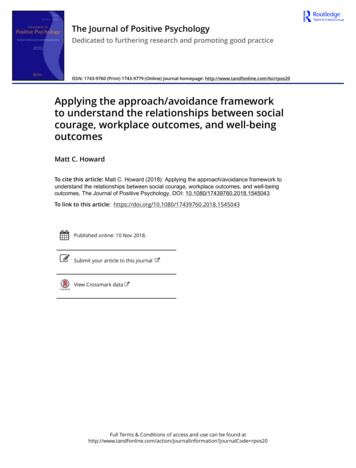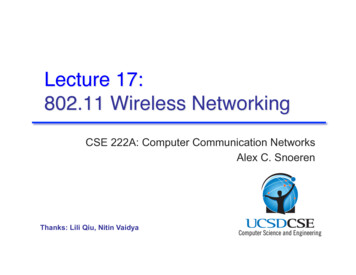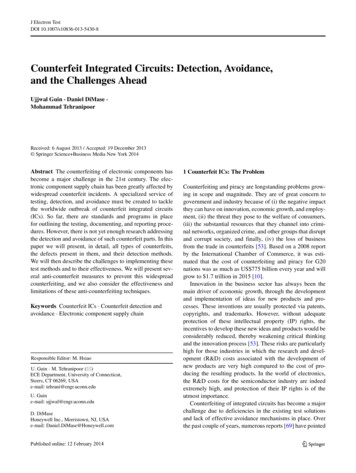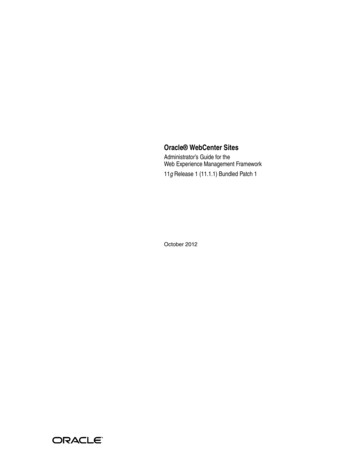
Transcription
The Journal of Positive PsychologyDedicated to furthering research and promoting good practiceISSN: 1743-9760 (Print) 1743-9779 (Online) Journal homepage: http://www.tandfonline.com/loi/rpos20Applying the approach/avoidance frameworkto understand the relationships between socialcourage, workplace outcomes, and well-beingoutcomesMatt C. HowardTo cite this article: Matt C. Howard (2018): Applying the approach/avoidance framework tounderstand the relationships between social courage, workplace outcomes, and well-beingoutcomes, The Journal of Positive Psychology, DOI: 10.1080/17439760.2018.1545043To link to this article: shed online: 10 Nov 2018.Submit your article to this journalView Crossmark dataFull Terms & Conditions of access and use can be found tion?journalCode rpos20
THE JOURNAL OF POSITIVE 45043Applying the approach/avoidance framework to understand the relationshipsbetween social courage, workplace outcomes, and well-being outcomesMatt C. HowardMitchell College of Business, The University of South Alabama, Mobile, AL, USAABSTRACTARTICLE HISTORYThe current article heeds three prior calls to advance the study of courage. First, we replicate priorfindings regarding the relationship of social courage and work outcomes, but we also investigate, forthe first time, the relationship between social courage and well-being outcomes. Second, we applythe approach/avoidance framework to understand how social courage influences these outcomes.Third, approach and avoidance motivations are tested as mediators of the relationships of socialcourage with outcomes while controlling for established aspects of personality, conscientiousnessand neuroticism. Two longitudinal studies show that approach motivation is a robust mediatorbetween courage and both workplace and well-being outcomes, suggesting that courageousindividuals achieve positive outcomes because they particularly value the benefits in such actions.Avoidance motivation was a less consistent mediator. Implications are discussed, but it should beemphasized that broader relationships of social courage can now be identified by applying theapproach/avoidance framework.Received 15 June 2018Accepted 25 October 2018Many important strides have been made in recent courage research. Rate et al.,(2007; Rate, 2010) developeda definition that has now become widespread (Howard& Alipour, 2014; Koerner, 2014; Schilpzand, Hekman, &Mitchell, 2014; Sekerka, Bagozzi, & Charnigo, 2009). Thisdefinition specifies that courage is a ‘(a) willful, intentional act, (b) executed after mindful deliberation, (c)involving objective substantial risk to the actor, (d)primarily motivated to bring about a noble good orworthy end’ (Rate et al., 2007, p. 95). From this perspective, several authors have developed theoretical modelsto identify possible outcomes of courage (Hannah,Sweeney, & Lester, 2007; Schilpzand et al., 2014;Sekerka et al., 2009), and some authors have begun toempirically test these relationships (Howard, Farr,Grandey, & Gutworth, 2017; Koerner, 2014). Particulardimensions of courage with notable importance haveeven been identified (Hannah, Avolio, & Walumbwa,2011; Howard et al., 2017). These include physical courage, moral courage, and social courage – the latter ofthese being the focus of the current article. Across allthese streams of research, three calls have been made(Hannah et al., 2011; Howard et al., 2017; Koerner, 2014;Schilpzand et al., 2014; Sekerka et al., 2009).First, authors have called for future research to replicatethe limited extant findings and test a wider range of noveloutcomes. Replication could ensure the validity of priorCONTACT Matt C. HowardMHoward@SouthAlabama.edu 2018 Informa UK Limited, trading as Taylor & Francis GroupKEYWORDSCourage; social courage;approach/avoidanceframework; I-O Psychologyfindings, but discovering new outcomes also stresses theimportance of courage to modern society. Second, authorshave called for researchers to identify mediators of therelationships between courage and outcomes in order todetermine how courage may influence outcomes. Third,authors have also called for future research to integrateprior theory into the study of courage. Integrating priortheory can allow courage to be linked to a broader theoretical network, and the results of prior research in associateddomains could be used to better understand courage itself.In response to these calls, the current article analyzesthe relationship of social courage with workplace outcomes, which has been tested in a prior study (Howardet al., 2017), but it also investigates the relationship of socialcourage with well-being outcomes for the first time. Theseworkplace outcomes include organizational citizenshipbehaviors (OCBs), employee voice behaviors, and counterproductive work behaviors (CWBs), whereas the well-beingoutcomes include stress, depression, anxiety, and life satisfaction. In testing these relationships, a novel framework isapplied to link social courage with prior theory: theapproach/avoidance framework (Dickson, Moberly, O’Dea,& Field, 2016; Elliot & Covington, 2001; Elliot & Thrash, 2002;Ferris, Yan, Lim, Chen, & Fatimah, 2016; Hangen, Elliot, &Jamieson, 2018; Mascret, Elliot, & Cury, 2015). The currentarticle tests whether approach and avoidance motivationsmediate the relationships between social courage and its
2M. C. HOWARDoutcomes, which could identify how social courage relatesto outcomes. Lastly, the current article tests whether theseobserved relationships still hold when controlling forconscientiousness and neuroticism, thereby identifyingwhether social courage relates to mediators and outcomesbeyond established aspects of personality. Together, thecurrent article satisfies many prior calls for future research,and provides a better understanding of courage and socialcourage.BackgroundCourage and social courageCourage has been conceptualized as both a trait anda behavior. People can perform courageous acts, butthey can also be considered courageous. Pury andStarkey (2010) label this the difference between courageas a process and as an accolade. Historically, greaterattention has been paid to courage as an accolade,which is reflected in the numerous awards given to courageous people (i.e. The Carnegie Medal, Ed Block Award)rather than awards given for solitary courageous acts(Pury & Starkey, 2010). In research, however, treatingcourage as an accolade has resulted in certain concerns;notably, created definitions are often vague and cannotclearly differentiate courageous people from noncourageous people. For this reason, a number of authorshave developed definitions that treat courage asa process, and those that habitually perform courageousacts are considered to possess the trait of courage.Perhaps the most theoretically supported of these definitions is that of Rate et al.,(2007, Rate, 2010), which includesfour primary aspects: intention, deliberation, risk, andprosocial intentions. In the current article, we apply thisdefinition as our conceptualization of courage.Further, courage is believed to be a multidimensionalconstruct (Howard et al., 2017; May, 1994; Schilpzand,2008; Woodard & Pury, 2007). Authors have differed ontheir methods to theorize the dimensions of courage,but it is perhaps most common to identify the dimensions by the associated risks involved with a behavior(i.e. physical courage, social courage; Howard et al., 2017;May, 1994; Schilpzand, 2008; Woodard & Pury, 2007).From this conceptualization, people may habitually perform courageous behaviors with certain types of associated risk, such as the risk of bodily harm, but the samepeople may habitually retreat from courageous behaviors with other types of associated risk, such as therisk of damaging social relationships.While many of these courage dimensions are assumedto be important, the current article investigates the dimension of social courage. Social courage has repeatedlyappeared in authors’ proposed dimensions of courage(May, 1994; Schilpzand, 2008; Woodard & Pury, 2007), andit is defined as a courageous behavior ‘in which the risksinvolved are to the actor’s esteem in the eyes of others’(Howard et al., 2017, p. 3). Typically, these risks relate todamaging one’s relationships and/or social image, butother social risks may also be included. Further, manyauthors have stressed the importance of social courage,particularly its influence on the modern workplace (Geller &Veazie, 2009; Koerner, 2014; Worline, 2012). Employees areoften expected to perform actions that may risk their relationships or social image for the benefit of their organization, coworkers, or even self (examples provided below).We argue, however, that social courage may also be important to well-being outcomes. Therefore, given the conceptual support for the existence and importance of socialcourage, we provide hypotheses regarding its organizational outcomes, well-being outcomes, and mediators ofthese relationships.Hypothesis developmentPrior empirical work and theoretical discussions on socialcourage have largely associated the construct with twocategories of outcomes. The first is workplace outcomes.Many workplace interactions involve social conflict.Employees are often expected to give group presentations, although they may fear public speaking.Coworkers are expected to correct one another, even ifit could damage friendships. Supervisors are evenexpected to discipline subordinates, which could createtension in any relationship. Identifying employees thatmay be more willing to perform these behaviors despiterisks could provide large organizational benefits.The goal of identifying socially courageous employees was achieved by Howard et al. (2017). Theseauthors developed the Workplace Social CourageScale (WSCS) and provided evidence of satisfactory psychometric properties and validity. Using this scale, it isindeed possible to measure social courage in an accurate manner. Howard et al. (2017) also provided initialevidence that social courage significantly relates toworkplace outcomes, but the authors stressed theimportance of replicating these results. For this reason,we retest the relationship of social courage with workplace outcomes. We expect social courage to havea positive relationship with organizational citizenshipbehaviors (OCBs) and voice, while we expect it tohave a negative relationship with counterproductivework behaviors (CWBs).Hypothesis 1: Workplace social courage has a significantrelationship with (a) OCBs, (b) voice, and (c) CWBs.
THE JOURNAL OF POSITIVE PSYCHOLOGYThe second category is well-being outcomes. Weconceptualize well-being as the presence (absence) ofemotional and cognitive states that reflect a positiveand healthy (negative and unhealthy) state of being(Brown & Ryan, 2003; Kasser et al., 2014). While it isrecognized that well-being is composed of severaldimensions (Ryff, 1989; Ryff & Keyes, 1995), we studya general conceptualization of well-being in the currentarticle, which is common in prior research (Brown &Ryan, 2003; Kasser et al., 2014). Specifically, we operationalize well-being as higher life satisfaction and lowerstress, depression, and anxiety.Those who are more courageous are often believedto have better personal well-being (Hannah et al., 2007;Howard et al., 2017; Schilpzand et al., 2014). This maybe because courageous people are fulfilled by theirprosocial actions, thereby resulting in more positivemental states. It may also be because courageous people tend to be more resilient to the ‘little things in life,’because they often pit themselves against larger adversity. Even yet, it may be because the outcomes of socialcourage behaviors often result in positive personal outcomes. For instance, an employee that gives grouppresentations and corrects coworkers may be identifiedas a high performer, and they may be more likely to bepromoted and/or commended for their actions. Thesebeneficial personal outcomes may in-turn improve thepsychological states of those who habitually performsocial courage behaviors.To date, very little empirical work has linked socialcourage with well-being outcomes. Koerner (2014) qualitatively studied the effect of courageous acts on identity formation. The results suggested that these actsshifted the manner in which employees viewed themselves, often causing employees to attribute positivecharacteristics to themselves (i.e. powerful, noble, etc.).In turn, these employees with positive views of themselves may have better personal well-being outcomes.Therefore, we expect social courage to have a negativerelationship with stress, depression, and anxiety, whilehaving a positive relationship with life satisfaction.Hypothesis 2: Workplace social courage has a significantrelationship with (a) stress, (b) depression, (c) anxiety,and (d) life satisfaction.While it is important to demonstrate that socialcourage influences workplace and well-being outcomes, it is perhaps more important to show how it isrelated to these outcomes. Doing so could providea theoretical lens to further study social courage,which could then be used to integrate the constructinto prior research and practice from this perspective.3Some frameworks have been developed to understand the trait of courage and its surrounding relationships – both antecedents and outcomes (Hannah et al.,2007; Koerner, 2014; Schilpzand et al., 2014; Sekerka &Bagozzi, 2007). These frameworks often differ in regardto the associated theories used to explain these relationships, but most all speculate that courageous people have the systematic tendency to strive through riskwhereas others would retreat. Given this particular consistency, we integrate a relevant theoretical perspectiveto study the mediator(s) between courage and its antecedents: the approach/avoidance framework.The approach/avoidance framework suggests thathumans and most animals have two separate regulatory processes: to strive towards desirable stimuli(approach) and to avoid undesirable stimuli (avoidance;Elliot & Covington, 2001; Elliot & Thrash, 2002; Roth &Cohen, 1986). In certain contexts, a particular regulatoryprocess may become more salient. For instance, ina toxic work environment, employees may be morefocused on avoiding the excessive undesirable stimulirather than striving towards organizational goals. Also,certain types of people also express a tendency towardsa particular regulatory process. That is, some peoplehabitually strive towards desirable stimuli, whereasothers habitually strive away from undesirable stimuli.This would be considered having an approach or avoidance orientation.Even yet, approach and avoidance motivationsrepresent short-term and/or goal-directed efforts thatrelate to these underlying tendencies (Elliot & Thrash,2002; Pintrich, 2000; Roth & Cohen, 1986). People thathave an underlying approach orientation tend to havean approach motivation, and people with an underlyingavoidance orientation tend to have an avoidance motivation; however, such people may still express theopposing motivation in certain situations. Prior studieshave shown that certain aspects of personality, such asconscientiousness and neuroticism, may cause peopleto be more likely to express these motivations (Elliot &Thrash, 2002, 2010; Foster & Trimm, 2008; Heimpel,Elliot, & Wood, 2006). We propose that the same istrue for social courage, even when controlling for conscientiousness and neuroticism.The relationship between social courage andapproach motivation is clear. Courageous people arebelieved to be more driven towards the benefits oftheir actions, and would thereby be more attracted tothe possible prosocial outcomes. Aspects of personality,however, may relate to both types of motivations (Elliot& Thrash, 2002, 2010; Ferris et al., 2011; Foster & Trimm,2008; Heimpel et al., 2006), which we suggest is thecase with social courage. In addition to promoting an
4M. C. HOWARDapproach motivation, we suggest that social couragemay also reduce avoidance motivation. That is, courageous people are less sensitive to undesirable stimuli,and thereby would be less likely to fret the risks associated with an act (Cox, Hallam, O’Connor, & Rachman,1983; McMillan & Rachman, 1987). Based on this notion,we thereby hypothesize that, even when controlling forconscientiousness and neuroticism, social courage ispositively related to approach motivation and negatively related to avoidance motivation.Hypothesis 3: Workplace social courage is significantlyrelated to (a) approach motivation and (b) avoidancemotivation.Furthermore, approach and avoidance motivationshave been shown to influence both workplace andwell-being outcomes (Elliot & Thrash, 2002, 2010;Ferris et al., 2013, 2011; Pintrich, 2000; Roth & Cohen,1986). Because social courage is believed to systematically promote approach motivation and reduceavoidance motivation, it is predicted that these motivations serve as mediators between social courage andoutcomes. It is recognized, however, that one or both ofthese motivations may serve as mediator(s), and therefore no firm hypothesis is made regarding whetherapproach, avoid, or both motivations are mediator(s).Hypothesis 4: Approach and/or avoidance motivation(s)mediate the relationship between workplace socialcourage and (a) OCBs, (b) voice, (c) CWBs, (d) stress,(e) depression, (f) anxiety, and (g) life satisfaction.Overview of studiesTwo studies are performed to test these hypotheses.Both are time-separated studies, which allows for moreappropriate tests of mediation and helps address common-method bias. Study 2, however, also controls forconscientiousness and neuroticism in testing all relationships. Prior authors have stressed the importanceof showing that courage predicts outcomes beyondestablished aspects of personality, such as the Big Fivepersonality facets (Hannah et al., 2007; Koerner, 2014;Schilpzand et al., 2014; Sekerka & Bagozzi, 2007).Observing the effects of courage beyond these established aspects of personality can emphasize the importance of the construct as a novel and independentaspect of the self. Our choice to control for conscientiousness and neuroticism, specifically, is also guided byprior research on courage.In regard to the workplace outcomes of social courage, Howard et al. (2017) suggested that social courageshould predict outcomes stronger than conscientiousness, as this is an aspect of personality with ample priorsupport for its relationship with workplace outcomes.Conscientiousness describes the tendency to be hardworking, goal-oriented, and organized (Barrick & Mount,1991; Goldberg, 1992). In Study 2, we control for conscientiousness to support that social courage predictsoutcomes beyond this established aspect of personality.Additionally, neuroticism is strongly associated withwell-being outcomes (Costa & McCrae, 1980; DeNeve &Cooper, 1998). Neuroticism describes the tendency tobe moody, emotional, and negative (Goldberg, 1990,1992). We also control for neuroticism in Study 2 tosupport that social courage predicts outcomes beyondthis established aspect of personalityStudy 1ParticipantsParticipants (N 244, Mage 37.44, SDage 11.60, 48%female, 91% American) were recruited from MTurk andprovided a small amount of monetary compensation.MTurk is a website that connects individuals willing toperform tasks on a computer, such as taking a survey,with those needing the tasks completed. Several priorstudies have shown that results obtained from MTurksamples are reliable and valid, even when studying special populations (Buhrmester, Kwang, & Gosling, 2011;Casler, Bickel, & Hackett, 2013; Paolacci & Chandler,2014; Shapiro, Chandler, & Mueller, 2013). All participantswere currently working (100%; MTenure 6.15 years,SDTenure 5.92 years; 77% full-time status).1 BecauseStudy 1 included many attention checks (5; e.g. ‘Pleasemark agree to show that you are paying attention’),those that failed more than one-fifth of the attentionchecks were removed (13 participants). All statistics,including the sample size, reflect the sample afterremoving these participants.ProcedureParticipants signed up for the study via MTurk. Theyprovided their digital informed consent, and enrolledinto the study. Each week for the following threeweeks, the participants completed Time 1 (244 participants), Time 2 (196 participants), and Time 3 (177 participants) surveys. Demographic information andworkplace social courage were measured at Time 1.Approach and avoidance motivations were measured atTime 2. All outcomes were measured at Time 3.Participants were debriefed about the project at theconclusion.
THE JOURNAL OF POSITIVE PSYCHOLOGYMeasuresUnless otherwise noted, all measures included a 1(Strongly Disagree) to 7 (Strongly Agree) scale, andscale scores were created by averaging participantresponses for each item.Workplace social courageWorkplace social courage was measured with the scale ofHoward et al. (2017). The scale includes 11 items, and anexample item is, ‘If I thought a question was dumb, I wouldstill ask it if I didn’t understand something at work.’Approach and avoidance motivationApproach and avoidance motivations were measuredwith the scale of Ferris et al. (2013). The scale includessix items for each motivation, and example items are:‘My goal at work is to fulfill my potential to the fullest inmy job’ (approach motivation) and “I think about thenegative outcomes associated with losing my job(avoidance motivation).Stress, depression, and anxietyStress, depression, and anxiety were measured with theDASS-21 (Antony, Bieling, Cox, Enns, & Swinson, 1998).The scale includes seven items for each construct andexample items are: ‘I found it hard to wind down’(stress), ‘I couldn’t seem to experience any positivefeeling at all’ (depression), and ‘I felt scared withoutany good reason’ (anxiety).Life satisfactionLife satisfaction was measured with the scale of Diener,Emmons, Larsen, and Griffin (1985). The scale includesfive items, and an example item is: ‘The conditions ofmy life are excellent.’OCBsOCBs were measured with the scale of Williams andAnderson (1991). The scale includes 13 items, and anexample item is, ‘Helps others who have been absent.’5VoiceVoice was measured with the scale of Van Dyne andLePine (1998). The scale includes six items, and anexample item is, ‘I develop and make recommendationsconcerning issues that affect this workgroup.’CWBsCWBs were measured with the scale of Bennett andRobinson (2000), which was created to gauge interpersonal and organizational deviance at work. The scaleincludes 19 items, and an example item is, ‘Made fun ofsomeone at work.’ResultsCorrelations and Cronbach’s alphas are presented inTable 1. Social courage’s relationships with outcomesranged from small (stress, r .19, p .01; anxiety,r .20, p .01; life satisfaction, r .15, p .05), tomoderate (depression, r .26, p .01; OCBs, r .40,p .01; CWBs, r .24, p .01), to large (voice, r .54,p .01). Each of these relationships were statisticallysignificant, supporting Hypotheses 1a, 1b, 1c, 2a, 2b, 2c,and 2d.Social courage also had a large, positive relationshipwith approach motivation (r .46, p .01) as well asa moderate, negative relationship with avoidance motivation (r .24, p .01). These results supportHypothesis 3a and 3b.Table 2 includes the results of seven separate regressions. Social courage is included in Step 1 of eachregression, followed by the inclusion of approach andavoidance motivations in Step 2. Mediation could betested by comparing Step 1 and Step 2 of Table 2(Baron & Kenny, 1986); however, many authors havecriticized this method for its inaccuracy (MacKinnon,Lockwood, Hoffman, West, & Sheets, 2002; Preacher &Hayes, 2004). For this reason, we used Hayes’s PROCESSmacro to calculate bootstrapped estimates of indirecteffects and confidence intervals, which are consideredTable 1. Correlations and Cronbach’s alphas of study 1.1.) Workplace Social Courage2.) Approach Motivation3.) Avoidance Motivation4.) Stress5.) Depression6.) Anxiety7.) Life Satisfaction8.) Organizational Citizenship Behaviors9.) Voice10.) Counterproductive Work Behaviors* p .05** p .011.85.46** .24** .19** .26** .20**.15*.40**.54** .21**2345678910.87 .24** .29** .45** .20**.34**.54**.59** .17*.86.57**.54**.50**.20** .36** .22**.41**.90.78**.77** .26** .38** .29**.45**.94.75** .43** .45** .33**.43**.89.16* .36** .20**.56**.91.20**.34**.01.82.58** .43**.90.17*.94
6 1.886.13more accurate tests of mediation (Hayes, 2009, 2012,2016). In the following paragraph, we present theresults of the cumulative indirect effect of social courage through both approach and avoidance motivationsin predicting outcomes.The overall indirect effect of social courage throughboth approach and avoidance motivations was significant for the outcomes of OCBs (B .230, S.E. .050, 95%C.I. [.142, .340), voice (B .272, S.E. .063, 95% C.I. [.165,.412], CWBs (B .112, S.E. .052, 95% C.I. [ .218, .013],stress (B .349, S.E. .091, 95% C.I. [ .537, .183],depression (B .462, S.E. .090, 95% C.I. [ .649, .297], anxiety (B .208, S.E. .074, 95% C.I. [ .358, .067], and life satisfaction (B .330, S.E. .084, 95%C.I. [.179, .508]. The direct effect was still significant forthe outcomes of OCBs (B .125, S.E. .062, 95% C.I.[.002, .248] and voice (B .404, S.E. .084, 95% C.I. [.239,.569], but it was no longer significant for the tests ofstress (B .040, S.E. .114, 95% C.I. [ .185, .264], depression (B .056, S.E. .107, 95% C.I. [ .156, .268], anxiety(B .074, S.E. .106, 95% C.I. [ .284, .135], life satisfaction (B .075, S.E. .141, 95% C.I. [ .353, .202], andCWBs (B .099, S.E. .081, 95% C.I. [ .258, .060].These results support Hypotheses 4a through 4g.Lastly, it should be noted that the indirect effectthrough approach motivation was stronger than theindirect effect through avoidance motivation for the following outcomes: OCBs, voice, depression, and life satisfaction. Also, the indirect effect through approachmotivation alone was significant for each outcome exceptCWBs and anxiety. The indirect effect through avoidancemotivation alone was significant for each outcome exceptvoice and life satisfaction. Thus, in Study 1, both approachand avoidance motivations were mediators betweensocial courage and outcomes, with approach motivationas a slightly more consistent mediator. .138 .044.326t3.160** .5363.997**.025.265**.18.3783.668** 1.234 .403 .098 .032.048.046** 2.834** .04 .646.43 .209.29 3.564**.36 .226Participants* p .05** p .01.400.16.5368.548**2.011*5.964**.141.417Study 2Constant1.) Workplace Social Courage2.) ApproachMotivation3.) Avoidance MotivationR2β10.701**5.774**βttStep 2Step 1Organizational Citizenship BehaviorsβStep 30**6.455**βStep 2t7.677**.41.468.320.426ttβStep 2Step 1.04Counterproductive Work Behaviors.4696.860**.26.149 .053 .062 .202.035 .358 .256.025 .174 .194Constant1.) Workplace Social Courage2.) ApproachMotivation3.) Avoidance MotivationR2Step 2βt4.772**1.989*t2.475* .700 .826t7.033** 2.731**t4.677**.523 5.316**t7.413** 3.510**t2.825**.348 2.460*t7.141** 2.617*βStep 1Table 2. Regression results of study 1.StressβStep 2βStep 1DepressionβStep 2βStep 1AnxietyβStep 2βStep 1Life SatisfactionM. C. HOWARDParticipants (N 502, Mage 32.88, SDage 9.34, 44%female, 84% American) were recruited from MTurk andprovided a small amount of monetary compensation.All participants were currently working (100%; MTenure 5.18 years, SDTenure 5.70 years; 84% full-time status),and no participant participated both Study 1 and Study2. Because Study 2 included many attention checks (8;e.g. ‘Please mark agree to show that you are payingattention’), those that failed more than one-fourth ofthe attention checks were removed (15 participants). Allstatistics, including the sample size, reflect the sampleafter removing these participants.
THE JOURNAL OF POSITIVE PSYCHOLOGYProcedure7regression. In Step 1, social courage was a significantpredictor of OCBs (β .309, t 4.919, p .01), CWBs(β .171, t 2.677, p .01), voice (β .430,t 7.231, p .01), depression (β .157, t 2.828,p .01), and life satisfaction (β .128, t 2.050,p .05). It was not a significant predictor of stress(β .035, t .674, p .05) and anxiety (β .077,t 1.301, p .05). These results support Hypotheses1a through 2d, except Hypothesis 2a and 2c.Table 5 includes the results of two separate regressions. Conscientiousness and neuroticism are includedas control variables alongside social courage as predictors of approach and avoidance motivations. Theresults showed that social courage was a significantand positive predictor of approach motivation(β .300, t 4.964, p .01), but it was a nonsignificant predictor of avoidance motivation(β .076, t 1.301, p .05). For this reason, onlyapproach motivation is tested as a mediator betweensocial courage and outcomes. These results supportHypothesis 3a but not 3b.We used Hayes’s PROCESS macro to calculate bootstrapped estimates of indirect effects and confidenceintervals (Hayes, 2009, 2012, 2016). While controlling forconscientiousness and neuroticism, the overall indirecteffect of social courage through approach motivationwas significant for the outcomes of OCBs (B .082, S.E. .030, 95% C.I. [.035, .155], voice (B .155, S.E. .051,95% C.I. [.070, .275], CWBs (B .068, S.E. .025, 95% C.I.[ .128, .029], depression (B .116, S.E. .045, 95% C.I.[ .227, .045], and life satisfaction (B .123, S.E. .050,95% C.I. [.048, .249]. The direct effect was still significantfor the tests of OCBs (B .199, S.E. .057, 95% C.I. [.086,.311] and voice (B .407, S.E. .074, 95% C.I. [.261, .552],but it was no longer significant for the tests of depression (B .151,
courage, workplace outcomes, and well-being outcomes Matt C. Howard To cite this article: Matt C. Howard (2018): Applying the approach/avoidance framework to understand the relationships between social courage, workplace outcomes, and well-being outcomes, The Journal of Positive


![INDEX [ actmindfully .au]](/img/14/2016-complete-worksheets-for-russ-harris-act-books.jpg)
![INDEX [thehappinesstrap ]](/img/14/complete-worksheets-2014.jpg)






